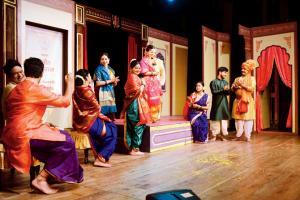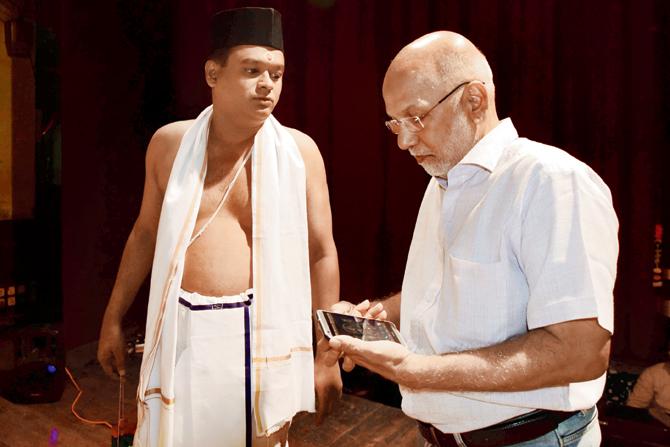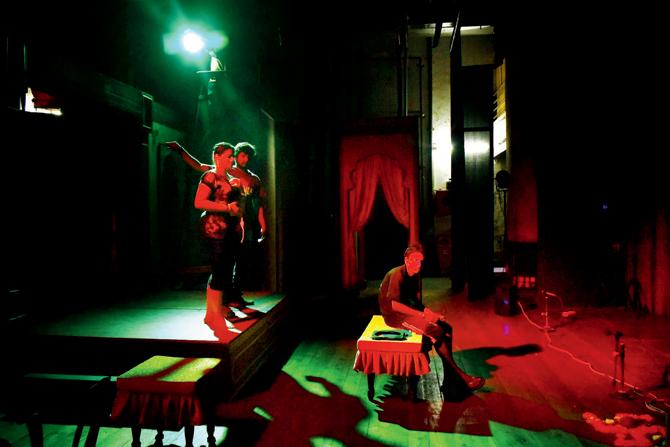While claiming to capture Marathi theatre's journey in a three-hour span, the play Chi Sau Ka turns into an orchestra of hummable songs from select musicals

Natyasampada Kala Manch's Chi Sau Ka Rangabhoomi has six songs from Vidyadhar Gokhale's three plays alongside works of 12 other playwrights. Pics/Suresh Karkera
 Vidyadhar Gokhale (1924-1996) was a warm chatty portly playwright-parliamentarian, never at a loss for witty word play. For media persons like me who covered his election from Mumbai North Central on a Shiv Sena ticket in 1989, he was a smiling unassertive vote-seeker who understood life's iniquities in Kurla's by-lanes. Unlike the extravagant rhetoric in his musical plays; his poll speeches were extraordinarily down-to-earth and large-hearted, often poking fun at himself. If Gokhale anna was alive to watch Natyasampada Kala Manch's recently-mounted Chi Sau Ka Rangabhoomi, in which six songs from his three plays have been cherry-picked, (alongside works of 12 playwrights) as the representational face of Marathi theatre, he would have chuckled over the basis of the projection.
Vidyadhar Gokhale (1924-1996) was a warm chatty portly playwright-parliamentarian, never at a loss for witty word play. For media persons like me who covered his election from Mumbai North Central on a Shiv Sena ticket in 1989, he was a smiling unassertive vote-seeker who understood life's iniquities in Kurla's by-lanes. Unlike the extravagant rhetoric in his musical plays; his poll speeches were extraordinarily down-to-earth and large-hearted, often poking fun at himself. If Gokhale anna was alive to watch Natyasampada Kala Manch's recently-mounted Chi Sau Ka Rangabhoomi, in which six songs from his three plays have been cherry-picked, (alongside works of 12 playwrights) as the representational face of Marathi theatre, he would have chuckled over the basis of the projection.
ADVERTISEMENT
For those who know the story of how he (as editor of Loksatta) invited a freelancer for tea (Kamlakar Nadkarni who had skillfully ripped apart Gokhale's play, Megh Malhar, years ago) and appointed him the paper's drama critic, so as to serve the larger cause of healthy theatre criticism, it is easier to imagine Gokhale's reaction to the attention devoted to his lyrics. Toppling his own natya pada Priticha (Prasiddhicha) Kalpataru Jo Mala Labhala (The bountiful tree of love, which is mine by good fortune), he would have inquired about the omitted milestone songs (the ones from the hugely popular Katyar Kaljat Ghusali whose central idea is supposed to have taken off from Gokhale's Mandarmala), which left their imprint on the theatregoers' collective consciousness. Being a believer in promoting fresh talent, he would have asked why Chi Sau Ka doesn't even mention an ongoing experimental musical like Devbabhabli, which brings saint Tukaram to life.

Producer Anant Panshikar with actor Amol Kulkarni on the sets of Chi Sau Ka
Since the play showcases a regional entertainment industry, which is theoretically 175 years old, one wonders why it chooses to end with a Jitendra Abhisheki number from the 1966 play Yayati Aani Devyani? Is there a sequel expected, of which the first part is devoted to musicals? Such questions become immaterial when the makers of Chi Sau Ka are governed by simple Math; their choices hinge on hummable songs, which do not necessarily chart a logical or chronological order.
Debutante playwright Sampada Joglekar Kulkarni sets out with the agenda of crafting a high-budget glossy production, resting on the shoulders of two resourceful finance generators, Yeshwant Deosthalee and Anant Panshikar. Hers is an invite to a feel-good wedding reception or a sponsored haldi kukum ceremony where the menu template is immovable and audience appreciation implicit in the metaphoric hyped-up marriage between the personified Marathi Rangbhoomi and Rasik Raj, the patron-audience.
Marriage is Chi Sau Ka's dramatic device to introduce a string of 33 excerpts - 27 melodies, six scenes from 22 plays, dating back to 1842. A cast of 12 actors take turns to sing popular songs from landmark productions - women decked up in bridal finery, men in suitable silk robes and phetas. The artistes sing well and look presentable. They would have been more believable if Chi Sau Ka had stuck to an honest limited trail - starting with the golden period (1850-1930), when musicals flourished as community entertainment, followed by their gradual loss of currency in proscenium space after the advent of cinema, ending with playwrights (like Gokhale), who revived the sangeet in the natak in the sixties. Gokhale's plays, seeped in shringar rasa and hyper allegorical lyrics, evoked respect and admiration only in certain middlebrow circles.

His right-wing political leanings had an impact on his literary mobility, as is evident in the fact that no mentionable director mounted his plays; not even the well-crafted Madanachi Manjiri (an adaptation of Shakespeare's Twelfth Night). He was written off as overly nostalgic about the sangeet natak era. His idea of theatre was perceived as songs interspersed with token dialogues. This fact cannot be disregarded in 2018 when Chi Sau Ka chooses to use Gokhale's lyrics to further its own saleability.
Natyasampada chooses the easy way out - use of centuries-old musical tracks: Narvar Krishna Samaan, Mhatara Ituka, Saptasur Zhankarit Bole, Nahi Mee Bolat - to evoke a sentimental audience reaction. Songs become the ultimate unit of appreciation in a three-hour orchestra. What about other energies that have gone into the making of the 175 years? What about the progressive narratives and dogged directors that have shaped the anti-establishment experimental form which till date shake the powers that be? What about a ground-breaking musical like Ghashiram Kotwal (1972), which travelled abroad in the teeth of prolonged litigation and political opposition? Or a musical like Mulgi Zhali Ho, which became the vehicle for the women's movement in the eighties and the nineties?
Chi Sau Ka prompted me to reread the eye-opening (out-of-print) slim book titled Marathi Natak Thitay Ka (Why is Marathi Theatre Inadequate?) penned by late senior critic Madhav Manohar, who has taken on several sangeet natak advocates for their self-soaked self-referential outlook towards theatre and the arts in general. He has not even spared legendary Bal Gandharva for not appreciating the economics of theatre production, especially since his debt-ridden natak mandali was answerable to many households. Manohar dismisses the culture of overspending on elegantly-mounted plays where true "drama" and the "conflict" is eclipsed by the singer-actor. He observes that musicals injected a distinct indiscipline in theatre arts; turning theatre into an acquired aural experience; turning the audience into listeners; turning actors into mere singers. He goes to the extent of calling the sangeet natak an enjoyable bhel, a tasty khichadi or a spicy missal with no specific locatable historical form like the Opera or the Ballet.
The critic blames the theatre-goer too in his postmortem of musicals; as the audience, looking for easy eyes-shut-ears-open entertainment, often prompted good writers to turn to indefinitely lengthy musicals whose last acts ended at day break. Eliciting the famous Krushnaji Prabharkar Khadilkar's Savai Madhavrao Yancha Mrutyu (1895) as a scintillating piece of prose, Manohar says the play suffered due to poor patronage; whereas Khadilkar's "pedestrian" Manapmaan (1911) attained immortality because of Bal Gandharva's voice. Similarly, Ekach Pyala is usually remembered in the context of songs like Kashiya Tyaju Padala (Chi Sau Ka also honours the dramatist for the lyrics), which were not even written by its playwright Ram Ganesh Gadkari, but his friend Vitthal Gurjar.
So the joke is that Gadkari's pyala was filled by the lyricist and the vocalist. Critics like Manohar present a view that many do not subscribe to; just as the makers of Chi Sau Ka who can and do rightfully celebrate the musical tradition. Pride is a relative concept. But any celebration cannot lack perspective; it cannot follow rules of convenience. A documentation of the arts calls for a need to rise above personal preconceived choices; a willingness to visit colliding worldviews. For those willing to explore, there is considerable multi-hued research on Marathi theatre done by experts like Makarand Sathe, Rajeev Naik, Pushpa Bhave, and Shanta Gokhale. Each scholar has his or her take, which one doesn't have to agree with, but one can draw inferences from.
Plays like Chi Sau Ka are often advanced with a something-is-better-than-nothing "consolation" logic; as if to underline the fact that some effort of keeping a tradition alive is better than no activity. But isn't it time to see if something is really better than nothing, or if that something is worse than nothing.
Sumedha Raikar-Mhatre is a culture columnist in search of the sub-text. You can reach her at sumedha.raikar@gmail.com
Catch up on all the latest Mumbai news, crime news, current affairs, and also a complete guide on Mumbai from food to things to do and events across the city here. Also download the new mid-day Android and iOS apps to get latest updates
 Subscribe today by clicking the link and stay updated with the latest news!" Click here!
Subscribe today by clicking the link and stay updated with the latest news!" Click here!







